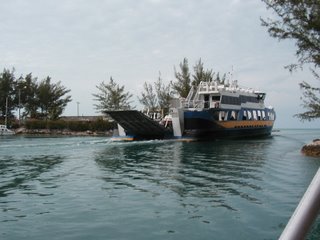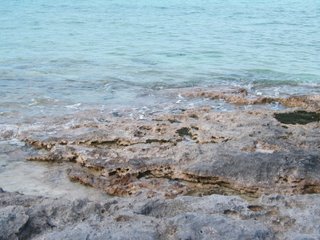Every area in the Bahamas has its own ambience. The parts of Andros we visited were different from Great Harbour Cay, and the islands of the Exumas are different from them and from each other. From Fresh Creek on Andros we crossed Tongue of the Ocean and the Great Bahama Bank to Highborne Cay, stopping overnight on the Bank. For part of one afternoon we anchored in the crystal clear waters off Highborne Cay, until increasingly high waves and winds made us decide to head for the all-weather anchorage at nearby Allen's Cay. And there we stayed for the next five days, learning to cope with the effects of strong currents and winds (but sheltered from the high waves all around the cays we were anchored between). We learned that when both current and winds are strong and the oppose each other, the boat will dance up on her anchor and can sail it out if there is only one down. We are now much more experienced at doing the Bahamian moor, one anchor in the direction of each tidal flow and chains linked below the level of the keel.
Not that we spent all our time sitting anxiously on the boat. When the weather was relatively good we hopped into the dinghy and explored and visited. The cays around the anchorage were home to iguanas, which live protected lives there. They are large, ugly and fascinating. We watched them bask on the beaches with their heads toward the sun, nibble on seaweed and make the sand fly in front of their burrows. Almost as fascinating was watching the people who came to visit them, some brought in by large powerboats proclaiming themselves to be part of a Bahamian Adventure Tour. Most of them approached the iguanas with caution and did not linger long; some tried to feed them. The iguanas moved when disturbed but other than that largely ignored their visitors.
From Allen's Cay we travelled by dinghy to Highborne Cay a couple of times. This was our first experience with an increasingly common phenomenon in the Bahamas - the privately owned cay with a resort or marina or both on it. The marina and the beaches were the only places we could land, and walking around the island was not allowed except for guests at the marina or guest house. The marina itself was very friendly, offering a place to dispose of garbage (for a fee), access the internet (ditto), use the phone, buy groceries and fuel, and exchange books (free!). The beaches around it were beautiful, and in calm weather we saw several boats anchored off them. But the improving weather saw us moving on instead of joining them.
When we left Allen's Cay we enjoyed a good sail in brisk winds to Warderick Wells in the Exuma Cays Land and Sea Park. There we spent our first day anchored off the beach on the west side, enjoying the fact that there was no current and no need to worry about the boat riding up on her anchor. The next day we moved to one of the moorings off the park headquarters, and with brochure and map in hand began to explore the island.
The Park has been established as part of the effort to permanently preserve areas of ecological importance. The island once had forests with trees which were harvested, and for a short while had a settlement on it. Deforestation lead to erosion and changes in plant and animal life, and the settlement did not last long. Now the island is being allowed to regenerate, with the minimum of interference from humans, and visitors are asked to leave nothing and take nothing except pictures. We explored the trails, and swam off the beaches, and planned to return with snorkelling gear to look at the nearby reefs.
From Warderick Wells we enjoyed another good sail in brisk winds to an anchorage close to Staniel Cay. In the end we only lunched in the first spot we anchored in - the guides said it was an all-weather anchorage, but it was also rolly and unpleasant. The spot we moved to after lunch, off the beach west of Big Majors Spot, was much nicer. There was no current and the waters were calm. We took advantage of several days of good weather to stay there, visiting the swimming pigs, swimming off one of the beaches and dinghying to nearby Staniel Cay Yacht Club to visit the town and enjoy good food and free wi-fi access to the internet. We also saw our first Nurse Sharks and a large Ray - they also enjoy good food courtesy of the Yacht Club whenever fish are cleaned there.
We enjoyed Staniel Cay, where the yacht club brings together cruisers, cottage guests and Bahamians, and where stepping out of the yacht club gates takes you straight into the community. On the roads the most common vehicle is the golf cart, small, manoeuvrable and not too fast. They handle the narrow roads in town with ease, and you see them parked around houses, stores, church and the Yacht Club. In the Yacht Club there are always people coming and going, and the bar and restaurant are often full of visitors, mostly cruisers or cottage guests.
From there it was a short trip to a very different stop - the anchorage in the harbour off Black Point Settlement on Great Guana Cay. The only disadvantage to this anchorage is that it does not provide shelter from westerly winds; if not for that it would be easy to stay here longer than we did and enjoy the friendliness and cleanliness of the town. Life here moves at a slower, quieter pace, and there is a cluster of services very important to cruisers - laundromat, marine store, book swap, large clean grocery store, local restaurants, garbage disposal, even well water for those interested. We would have stayed longer, but there was a front approaching with strong winds and we needed a more protected place to be in when it passed.
So from Black Point we made another short hop to Little Farmers Cay. Our first night was pleasantly spent on the west side of the island, but the next mornng we moved to the more sheltered anchorage on the east side. There we dealt once again with the mix of strong currents and high winds, and practiced our Bahamian Moor techniques. Richard went ashore a couple of times on calmer days, for fish, bread and cheese, and spent time talking to some of the local fishermen. All went well, although a boat close to us dragged during the windiest night and we spent the balance of the night awake and watching ourselves and them. And then the wind died down, and it was hard to tell what all the fuss was all about. And it was time to head for George Town.
 This is a quiet day in the anchorage at Allens Cay in the Exumas. Allens Cay is inhabited mainly by iguanas, who sun themselves on the beaches and nibble on the seaweed washed up. The water is beautiful and clear - you can see the sandbar in the middle underneath it. The building in the background is a ruin; no person lives on the cay itself. The building is visible because almost all the trees are small - there is not much fresh water or soil here.
This is a quiet day in the anchorage at Allens Cay in the Exumas. Allens Cay is inhabited mainly by iguanas, who sun themselves on the beaches and nibble on the seaweed washed up. The water is beautiful and clear - you can see the sandbar in the middle underneath it. The building in the background is a ruin; no person lives on the cay itself. The building is visible because almost all the trees are small - there is not much fresh water or soil here. Warderick Wells, a part of the Exuma Cays Land and Sea Park, is fascinating. Once forested, it was stripped of its trees by the 1800s. Under the care of the Bahamas National Trust the island is being allowed to regenerate itself. Among its inhabitants, this little warbler, which flits past close to people and sits on the hands of those wishing to feed it without any fear.
Warderick Wells, a part of the Exuma Cays Land and Sea Park, is fascinating. Once forested, it was stripped of its trees by the 1800s. Under the care of the Bahamas National Trust the island is being allowed to regenerate itself. Among its inhabitants, this little warbler, which flits past close to people and sits on the hands of those wishing to feed it without any fear. This inhabitant of Warderick Wells is usually seen in motion, racing across the paths. This one, however, was sunning himself and did not care to move.
This inhabitant of Warderick Wells is usually seen in motion, racing across the paths. This one, however, was sunning himself and did not care to move.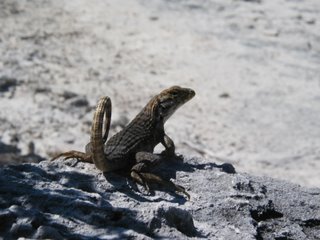 Yet another inhabitant of Warderick Wells, the Curly-Tailed Lizard likes to sun himself on the rocks which make up much of the terrain here.
Yet another inhabitant of Warderick Wells, the Curly-Tailed Lizard likes to sun himself on the rocks which make up much of the terrain here. Many parts of the trails we walked over looked like this, made up of very porous rock formed from the sand. They sometimes shift as you walk on them, and make music-like noises as they hit each other.
Many parts of the trails we walked over looked like this, made up of very porous rock formed from the sand. They sometimes shift as you walk on them, and make music-like noises as they hit each other.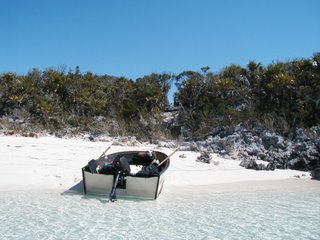 We did find a secluded beach, with beautiful white sand and no current, a great place to dip into the water. It is tucked away, we're not going to say where...
We did find a secluded beach, with beautiful white sand and no current, a great place to dip into the water. It is tucked away, we're not going to say where...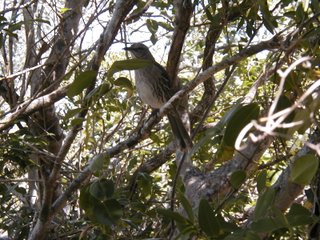 Another inhabitant of Warderick Wells we met on our walks, this Mockingbird was so sure that he was well camouflaged in the trees that he did not move as we took his picture.
Another inhabitant of Warderick Wells we met on our walks, this Mockingbird was so sure that he was well camouflaged in the trees that he did not move as we took his picture. Former human inhabitants of the island also left their traces. This is part of the ruins of the Davis Plantation, a Loyalist Settlement built in the late 1700s. A lot of work must have gone into building these walls, now in ruins, and looking at them makes you wonder what their lives were like.
Former human inhabitants of the island also left their traces. This is part of the ruins of the Davis Plantation, a Loyalist Settlement built in the late 1700s. A lot of work must have gone into building these walls, now in ruins, and looking at them makes you wonder what their lives were like. These are the swimming pigs of Big Majors Spot, an island close to Staniel Cay. We were told they will swim to your boat if you have food, but we did not put this to the test. They will certainly investigate any dinghy which arrives, with much snuffling and squealing, but they do not stay if there is no food to keep them interested.
These are the swimming pigs of Big Majors Spot, an island close to Staniel Cay. We were told they will swim to your boat if you have food, but we did not put this to the test. They will certainly investigate any dinghy which arrives, with much snuffling and squealing, but they do not stay if there is no food to keep them interested.


